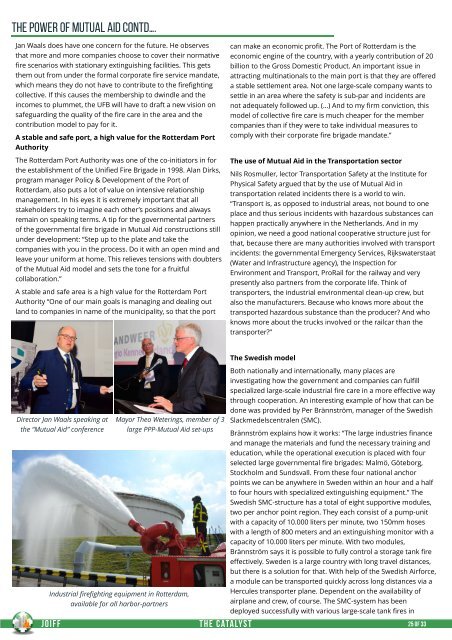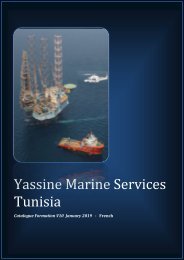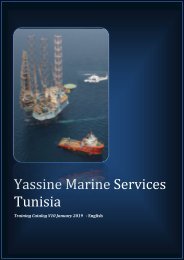The CATALYST_October_2017
Create successful ePaper yourself
Turn your PDF publications into a flip-book with our unique Google optimized e-Paper software.
the power of mutual aid contd….<br />
Jan Waals does have one concern for the future. He observes<br />
that more and more companies choose to cover their normative<br />
fire scenarios with stationary extinguishing facilities. This gets<br />
them out from under the formal corporate fire service mandate,<br />
which means they do not have to contribute to the firefighting<br />
collective. If this causes the membership to dwindle and the<br />
incomes to plummet, the UFB will have to draft a new vision on<br />
safeguarding the quality of the fire care in the area and the<br />
contribution model to pay for it.<br />
A stable and safe port, a high value for the Rotterdam Port<br />
Authority<br />
<strong>The</strong> Rotterdam Port Authority was one of the co-initiators in for<br />
the establishment of the Unified Fire Brigade in 1998. Alan Dirks,<br />
program manager Policy & Development of the Port of<br />
Rotterdam, also puts a lot of value on intensive relationship<br />
management. In his eyes it is extremely important that all<br />
stakeholders try to imagine each other’s positions and always<br />
remain on speaking terms. A tip for the governmental partners<br />
of the governmental fire brigade in Mutual Aid constructions still<br />
under development: “Step up to the plate and take the<br />
companies with you in the process. Do it with an open mind and<br />
leave your uniform at home. This relieves tensions with doubters<br />
of the Mutual Aid model and sets the tone for a fruitful<br />
collaboration.”<br />
A stable and safe area is a high value for the Rotterdam Port<br />
Authority “One of our main goals is managing and dealing out<br />
land to companies in name of the municipality, so that the port<br />
can make an economic profit. <strong>The</strong> Port of Rotterdam is the<br />
economic engine of the country, with a yearly contribution of 20<br />
billion to the Gross Domestic Product. An important issue in<br />
attracting multinationals to the main port is that they are offered<br />
a stable settlement area. Not one large-scale company wants to<br />
settle in an area where the safety is sub-par and incidents are<br />
not adequately followed up. (…) And to my firm conviction, this<br />
model of collective fire care is much cheaper for the member<br />
companies than if they were to take individual measures to<br />
comply with their corporate fire brigade mandate.”<br />
<strong>The</strong> use of Mutual Aid in the Transportation sector<br />
Nils Rosmuller, lector Transportation Safety at the Institute for<br />
Physical Safety argued that by the use of Mutual Aid in<br />
transportation related incidents there is a world to win.<br />
“Transport is, as opposed to industrial areas, not bound to one<br />
place and thus serious incidents with hazardous substances can<br />
happen practically anywhere in the Netherlands. And in my<br />
opinion, we need a good national cooperative structure just for<br />
that, because there are many authorities involved with transport<br />
incidents: the governmental Emergency Services, Rijkswaterstaat<br />
(Water and Infrastructure agency), the Inspection for<br />
Environment and Transport, ProRail for the railway and very<br />
presently also partners from the corporate life. Think of<br />
transporters, the industrial environmental clean-up crew, but<br />
also the manufacturers. Because who knows more about the<br />
transported hazardous substance than the producer? And who<br />
knows more about the trucks involved or the railcar than the<br />
transporter?”<br />
Director Jan Waals speaking at<br />
the “Mutual Aid” conference<br />
JOIFF<br />
Mayor <strong>The</strong>o Weterings, member of 3<br />
large PPP-Mutual Aid set-ups<br />
Industrial firefighting equipment in Rotterdam,<br />
available for all harbor-partners<br />
<strong>The</strong> Catalyst<br />
<strong>The</strong> Swedish model<br />
Both nationally and internationally, many places are<br />
investigating how the government and companies can fulfill<br />
specialized large-scale industrial fire care in a more effective way<br />
through cooperation. An interesting example of how that can be<br />
done was provided by Per Brännström, manager of the Swedish<br />
Slackmedelscentralen (SMC).<br />
Brännström explains how it works: “<strong>The</strong> large industries finance<br />
and manage the materials and fund the necessary training and<br />
education, while the operational execution is placed with four<br />
selected large governmental fire brigades: Malmö, Göteborg,<br />
Stockholm and Sundsvall. From these four national anchor<br />
points we can be anywhere in Sweden within an hour and a half<br />
to four hours with specialized extinguishing equipment.” <strong>The</strong><br />
Swedish SMC-structure has a total of eight supportive modules,<br />
two per anchor point region. <strong>The</strong>y each consist of a pump-unit<br />
with a capacity of 10.000 liters per minute, two 150mm hoses<br />
with a length of 800 meters and an extinguishing monitor with a<br />
capacity of 10.000 liters per minute. With two modules,<br />
Brännström says it is possible to fully control a storage tank fire<br />
effectively. Sweden is a large country with long travel distances,<br />
but there is a solution for that. With help of the Swedish Airforce,<br />
a module can be transported quickly across long distances via a<br />
Hercules transporter plane. Dependent on the availability of<br />
airplane and crew, of course. <strong>The</strong> SMC-system has been<br />
deployed successfully with various large-scale tank fires in<br />
25 of 33

















